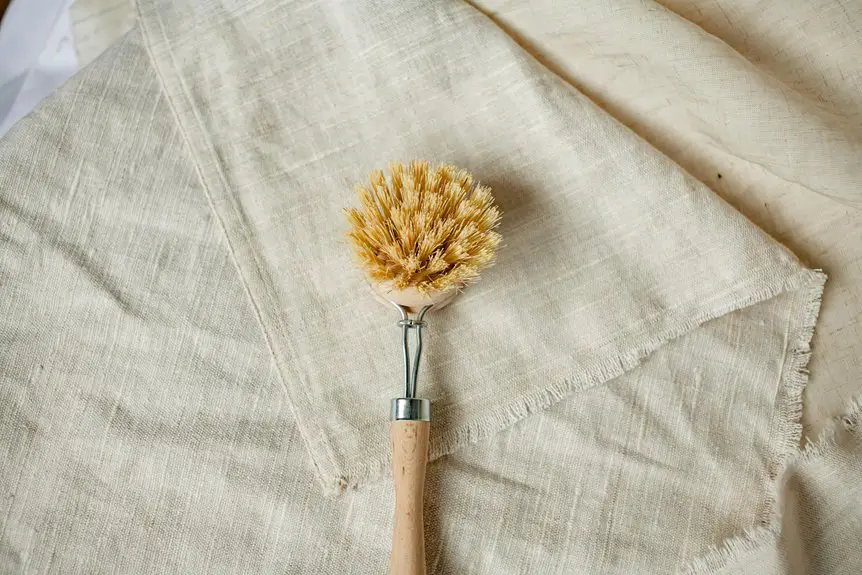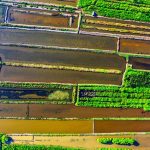Most conventional geotextile fabrics aren’t biodegradable and can last decades in the environment, potentially causing pollution. However, you can find biodegradable options made from natural fibers like jute or coir that break down much faster, often within months to a few years. These eco-friendly alternatives reduce waste and support soil health. If you want to understand the materials used and how to choose sustainable geotextiles, there’s more to explore on this topic.
Table of Contents
Key Takeaways
- Most conventional geotextile fabrics made from synthetic polymers are not biodegradable and persist in the environment for decades.
- Natural fiber geotextiles like jute, coir, and hemp are biodegradable and break down naturally in soil over months to years.
- Biodegradable geotextiles degrade faster in warm, moist conditions due to enhanced microbial and enzymatic activity.
- Some geotextile products combine natural fibers with bio-based polymers to support environmental sustainability and soil health.
- Verifying biodegradability claims through certifications ensures the geotextile fabric meets eco-friendly and degradation standards.
Composition and Types of Geotextile Fabrics
Geotextile fabrics come in several compositions, primarily made from synthetic fibers like polypropylene or polyester.
Geotextile fabrics are mainly crafted from synthetic fibers such as polypropylene or polyester for durability and strength.
When you choose a geotextile, you’ll find two main types: woven and non-woven. Woven geotextiles resemble fabric with a grid-like pattern, offering high strength and durability, perfect for reinforcement tasks. Non-woven geotextiles feel more like felt and provide excellent filtration and drainage. Some geotextiles combine these types to meet specific project needs.
While most are synthetic, you might also encounter natural fiber geotextiles made from jute or coir, which are less common but offer biodegradable options.
Understanding the composition and type helps you select the right fabric for soil stabilization, erosion control, or drainage without worrying about premature degradation during use.
Environmental Impact of Conventional Geotextiles
Although conventional geotextiles offer durability and strength, they can pose significant environmental challenges. When you use these synthetic fabrics, you mightn’t realize they’re made from non-biodegradable polymers like polypropylene or polyester.
Over time, these materials don’t break down naturally, leading to long-lasting waste in landfills or soil. If fragments enter waterways, they can harm aquatic life and disrupt ecosystems.
Additionally, producing these fabrics consumes fossil fuels and releases greenhouse gases, contributing to pollution. When conventional geotextiles eventually degrade through physical wear, they may release microplastics, further contaminating the environment.
Biodegradable Alternatives and Innovations
Concerns about the environmental impact of conventional geotextiles have pushed researchers and manufacturers to explore more sustainable options.
You’ll find biodegradable geotextiles made from natural fibers like jute, coir, and hemp gaining traction. These materials break down naturally, reducing long-term waste and soil contamination.
Innovations also include bio-based polymers derived from renewable resources, offering strength and durability while being eco-friendly. Some products combine natural fibers with biodegradable polymers to improve performance without sacrificing sustainability.
When you choose these alternatives, you support projects that minimize environmental harm and promote soil health.
While they may have shorter lifespans than synthetic fabrics, these biodegradable options fit well in applications like erosion control and landscaping, where temporary reinforcement is sufficient.
Degradation Process and Timeframe
When biodegradable fabrics break down, the process depends heavily on the material type and environmental conditions. You’ll notice the timeframe varies based on these factors.
Here’s what influences degradation:
- Material Composition – Natural fibers like jute degrade faster than synthetic blends.
- Moisture Levels – Higher moisture accelerates microbial activity, speeding up breakdown.
- Temperature – Warm environments enhance enzymatic reactions, shortening degradation time.
- Microbial Presence – Soil rich in bacteria and fungi promotes faster decomposition.
Typically, biodegradable geotextiles degrade within months to a few years.
You should consider these factors carefully, as they determine how long the fabric lasts before fully breaking down and returning to the environment. Understanding this helps you plan for your project’s longevity and environmental impact.
Choosing Sustainable Geotextile Solutions
Since sustainable geotextile options vary widely, you need to focus on materials that balance durability with environmental impact.
Look for fabrics made from natural fibers like jute or coir, which biodegrade naturally without leaving harmful residues. If you require longer-lasting solutions, consider recycled synthetic geotextiles, which reduce waste by repurposing plastic materials.
Avoid conventional polypropylene fabrics if you want to minimize environmental harm, as they persist in the environment for decades. Also, check certifications that verify eco-friendly production methods and biodegradability claims.
By choosing geotextiles that align with your project’s lifespan and ecological goals, you guarantee effective performance without compromising sustainability.
Frequently Asked Questions
How Do Geotextiles Improve Soil Stabilization in Construction Projects?
You improve soil stabilization by using geotextiles to reinforce soil, prevent erosion, and separate soil layers. They distribute loads evenly, enhance drainage, and increase soil strength, making construction projects more stable and durable.
Can Geotextile Fabrics Be Reused After Removal?
You can often reuse geotextile fabrics after removal if they remain intact and clean. Just make sure to inspect them for damage or contamination, as compromised fabric won’t perform effectively in new applications.
What Are the Cost Differences Between Woven and Non-Woven Geotextiles?
You’ll find woven geotextiles generally cost more due to durability and strength, while non-woven options are cheaper but less robust. Your choice depends on project needs and budget constraints.
Are There Specific Industries That Primarily Use Geotextile Fabrics?
You’ll find geotextile fabrics mainly used in construction, agriculture, and landscaping. They help with soil stabilization, erosion control, and drainage, making them essential in road building, landfills, and even sports field installations.
How Do Geotextiles Affect Water Drainage in Landscaping?
You’ll find geotextiles improve water drainage by allowing water to pass through while preventing soil erosion. They help maintain soil stability, reduce runoff, and promote healthier plant growth by managing water flow effectively in your landscaping projects.
- Does Chiffon Fabric Stink - July 15, 2025
- Does Chiffon Fabric Affect the Economy - July 15, 2025
- Does Cotton Fabric Have a Nap - July 15, 2025







